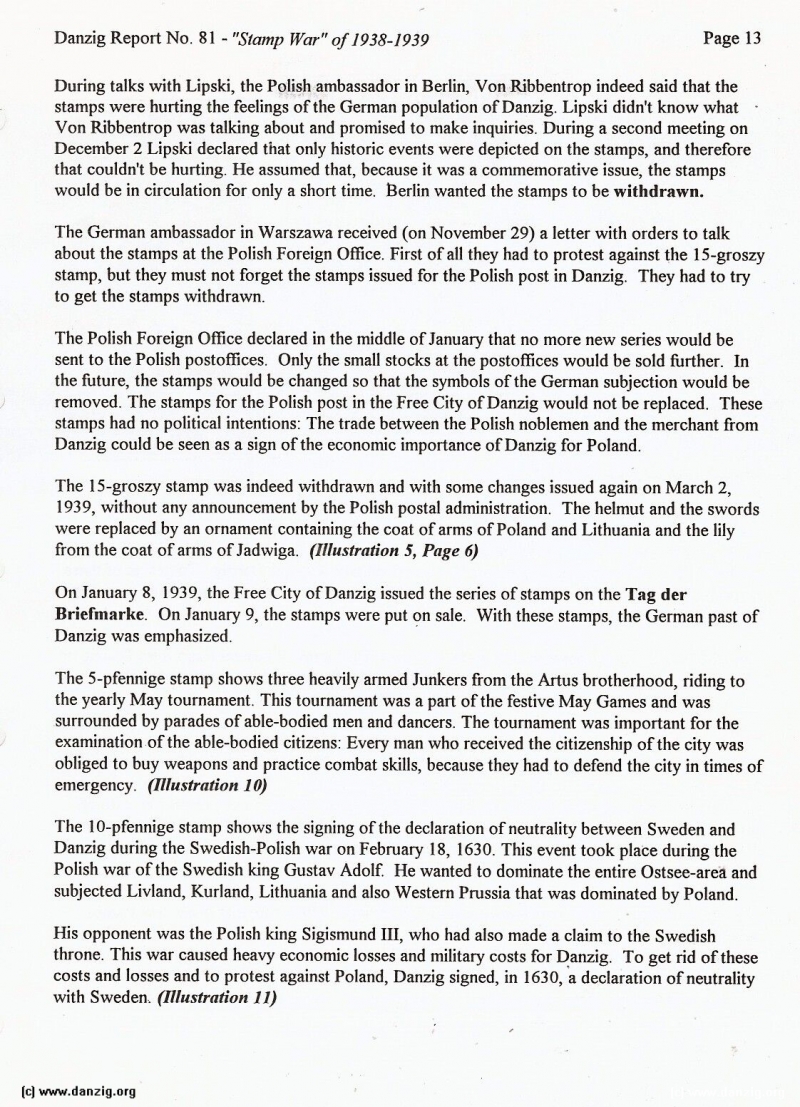
During talks with Lipski, the Polish ambassador in Berlin, Von Ribbentrop indeed said that the stamps were hurting the feelings of the German population of Danzig. Lipski didn’t know what Von Ribbentrop was talking about and promised to make inquiries. During a second meeting on December 2 Lipski declared that only historic events were depicted on the stamps, and therefore that couldn’t be hurting. He assumed that, because it was a commemorative issue, the stamps would be in circulation for only a short time. berlin wanted the stamps to be withdrawn.
The German ambassador in Warszawa received (on November 29) a letter with orders to talk about the stamps at the Polish Foreign Office. First of all they had to protest against the 1 5-groszy stamp, but they must not forget the stamps issued for the Polish post in Danzig. They had to try to get the stamps withdrawn.
The Polish Foreign Office declared in the middle of January that no more new series would be sent to the Polish postofTices. Only the small stocks at the postoffices would be sold further. In the future, the stamps would be changed so that the symbols of the German subjection would be removed. The stamps for the Polish post in the Free City of Danzig would not be replaced. These stamps had no political intentions: The trade between the Polish noblemen and the merchant from Danzig could be seen as a sign of the economic importance of Danzig for Poland.
The 1 5-groszy stamp was indeed withdrawn and with some changes issued again on March 2, 1939, without any announcement by the Polish postal administration. The helmut and the swords were replaced by an ornament containing the coat of arms of Poland and Lithuania and the lily from the coat of arms of Jadwiga. (Illustration 5, Page 6)
On January 8, 1939, the Free City of Danzig issued the series of stamps on the Tag der
Briefrnarke. On January 9, the stamps were put on sale. With these stamps, the German past of Danzig was emphasized.
The 5-pfennige stamp shows three heavily armed Junkers from the Artus brotherhood, riding to the yearly May tournament. This tournament was a part of the festive May Games and was surrounded by parades of able-bodied men and dancers. The tournament was important for the examination of the able-bodied citizens: Every man who received the citizenship of the city was obliged to buy weapons and practice combat skills, because they had to defend the city in times of emergency. (illustration 10)
The 10-pfennige stamp shows the signing of the declaration of neutrality between Sweden and Danzig during the Swedish-Polish war on February 18, 1630. This event took place during the Polish war of the Swedish king Gustav Adolf He wanted to dominate the entire Ostsee-area and subjected Liviand, Kurland, Lithuania and also Western Prussia that was dominated by Poland.
His opponent was the Polish king Sigismund III, who had also made a claim to the Swedish throne. This war caused heavy economic losses and military costs for Danzig. To get rid of these costs and losses and to protest against Poland, Danzig signed, in 1630, a declaration of neutrality with Sweden (Illustration 11)
Danzig Report Vol. 1 - Nr. 80 - October - November - December - 1993, Page 13.
Hits: 3668
Added: 06/07/2015
Copyright: 2025 Danzig.org

